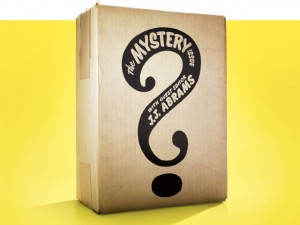Hippasus Gurgles: We are the Pattern-Makers, and We are the Dreamers of Dreams
Michael Carlisle examines the world “outside” sequential art to find… more sequential art.
I was reading the J.J. Abrams-edited issue of this month’s Wired magazine.

The cover of the Wired article is a reference to J.J. Abrams’ “mystery box”, that he refers to in his TED talk from 2007.
It simultaneously thrilled and depressed the hell out of me.
I know there are many puzzles embedded within; all one needs is time to unravel them.
Time is precisely one of the things I don’t have right now. I am still embarked on my long journey to take some existing logical sequences, change many of them in some slight way, reorder them a bit so a new logical sequence takes shape, and publish the results.
This takes a long time.
So there’s been a lot of studying, a lot of putting things “in the right order” so it all “makes sense”, whatever that means.
Sometimes I just like to see some things “out of order” (again, whatever that means).
Coming up with a winning order for a collection of objects, be it for reading comprehension, stylistic decisions, or just plain awesome, is hard work. Ask a museum curator or a DJ (a good DJ) some time. Or a comics creator, heh.
Now imagine putting all that work in, constructing an album, writing and drawing panel after panel after panel, filling pages with words put in just a particular sequence, and someone comes along and hits “random”.
That’s gotta suck.
Unless, of course, you like the idea.
Cut-Ups from Matti Niinimäki on Vimeo.
“Disordered” narratives are a certain type of puzzle. Telling a story in a nonlinear (or multi-linear) fashion forces the reader to do some work, which makes the satisfaction of experiencing the work all the greater once it’s been decoded. Sometimes reordering things exposes a reader to some underlying idea that may not have been apparent if things were told more linearly. Sometimes when changing the order, an intended narrative is changed. Sometimes, one materializes out of the aether.
Setting up a random sequence gives people ideas they wouldn’t have had otherwise. It’s easy to shuffle a deck and play solitaire, but it might be more satisfying to try interpreting your life through a tarot spread or playing a little 5-card Nancy. While the individual components may not have any inherent narrative, most human minds seem to enjoy generating narratives when presented with a sequence of statements, images, sounds, etc.
Have you ever seen Un chien andalou? You should.
I find this dreadfully fascinating since it’s part of my training as a mathematician (and should be part of the training of scientists, detectives, clinical psychologists, politicians, writers, and editors) to manipulate the narrative you are presented with, to bend it to your own ends. In my field, of course, we have to keep everything logically consistent; that isn’t a problem for some.
Brion Gysin and William Burroughs played with this idea back in the 1950s with the notion of cut-ups. They weren’t the first to use randomness, but the story of Gysin “discovering” cut-ups accidentally when slicing newspapers makes it seem as though “meaning” (i.e. a coherent narrative) was found through randomly combining blocks of text.
A puzzle without a solution.

We’ve seen that narratives can run in multiple threads, and we can often shuffle things around and still have a functional narrative. This just removes some (maybe all) of the control of the narrative from the creator and puts it in the hands of Reader and Nature.
However, an overall theme is not a sufficient substitute for a narrative, regardless of ordering. This is why I would say list shows and top-10 blog posts are not sequential art. (I’m not saying anyone actually says this, or they’re not fun to watch or read or anything… I’m just being pedantic for pedantry’s sake. btphbpthbtp)
This may be why many people opt for more straightforward media – no puzzles to solve, just a single narrative thread, recognizable character actors, laugh track, etc. No problem, just not as overall satisfying to me.
Biological evolution can be seen as a random process in which certain patterns persist and others don’t, given environmental constraints which are effectively random with some consistency. It can look from the “outside” as though there is a directed thread, since the victors often write the history. It’s possible that there is intent; likely to this mind, though, it’s just random blocks of molecules thrown together until something sticks around. From there, well, they just keep moving, some stick around, some don’t. We seem to have had some “good luck” (whatever that means) with the persistence of adenine-cytosine-guanine-thymine strings in various permutations.

“Magic” means two different things. For one, it is stage trickery – card tricks and the like. For another, it is its own set of sequences of non-intuitive ritualistic actions that bring about physical change in the universe (usually spelled nowadays as “magick”). Spooky action at a distance, indeed.
To mimic biology more effectively, one must use replication, recombination, and mutation in one’s work. No doubt you are doing this right now. “Creation” is a melange of these three functions, using memories and learned techniques as inputs. From there, it’s feedback-loop-mania.
If you ever look at “nature” as “art”, then who made it? If no one, then I guess you like aleatoric composition. So do I.
Replication: “He thinks I need to rewrite it. I said, ‘Fuck that, I’ll just make a copy.'”
Recombination is what parody is often about. Take two, juxtapose, laugh, profit.
Mutation can probably be attributed to decaying memories or other uncontrollable (ha) randomness. That, or ooze.
We tend to find patterns, where they exist and where they don’t. Maybe they don’t ever not exist; maybe it’s just that the pattern you’ve found isn’t the right one for the situation at hand. A conspiracy theory may not be “truth” and Occam may not be happy with you, but if it’s fun and interesting it’s worth something. Bible Codes are a perfect example of what you can find when your data set is large enough and you have enough free time on your hands to manipulate sequences. I’m sure Gysin didn’t see that coming… unless, of course, he had access to millenia-old Kabbalah. These guys were doing character-by-character cut-ups YEARS before the Beats!

“You’re no longer a mathematician… You’re a numerologist!”
Is playing a music player on “shuffle” an act of aleatoric art if you notice sufficient narrative or otherwise pleasing flow to the path your player makes? In an electronic music class I took quite a while ago, one assignment was to “compose” an aleatoric piece. Unaware of Zaireeka at the time (it had come out just 2 years earlier and I wasn’t big into The Flaming Lips), my project consisted of four CD players, on random, playing custom CDs I’d put together. One had children’s songs, one political clips, one movie quotes, and one random noises. The conditioning aspect of the piece was that the piece was started on one particular kids’ song and only ended when a certain other one came around. (I think I started with “London Bridge” and ended with “Ring Around the Rosy”, but I’m not sure now.) Since there was a definite end time, it was sure to be finite.
Would the “random” button even exist on CD and other digital music players without exquisite corpse?
My professor didn’t like it. Oh well. Does this mean it wasn’t any good?
Maybe randomness is just an excuse for a poorly-constructed narrative? You can’t come up with an overall thread with which to tell a story, so you jumble it up to make it look edgy? It’s possible.
Michael Carlisle is a mathematics Ph.D. candidate at the City University of New York, where he earned a certificate in Interactive Technology and Pedagogy. When not teaching or researching probability or rambling about dystopian films and surrealist animation, he volunteers with the Sequential Art Collective and New York Center for Independent Publishing.



Riddle me this…Have you solved the puzzles yet? What about now? Have you unlocked the magic behind the numbers? What’s taking so long, professor?